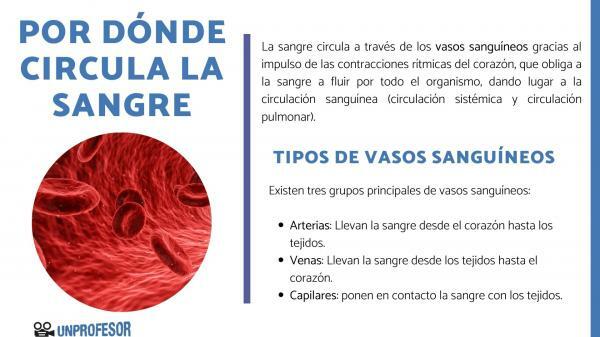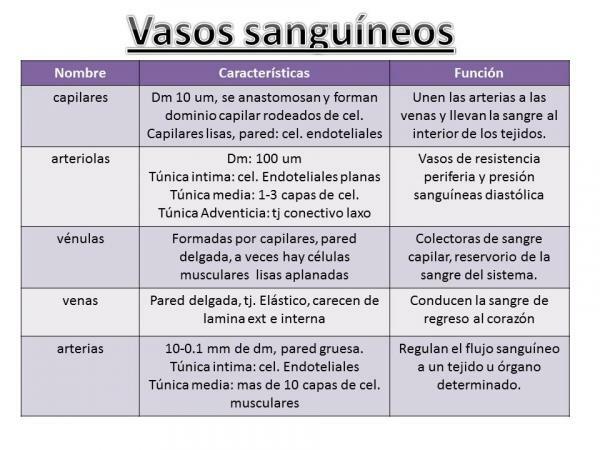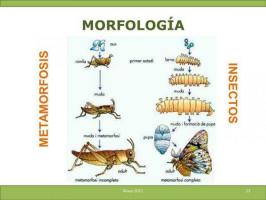Where the blood circulates

Blood circulates through blood vessels thanks to the impulse of the rhythmic contractions of the heart, which forces the blood to flow through the whole organism, giving rise to blood circulation (systemic circulation and circulation pulmonary).
In this lesson from a TEACHER we are going to tell you where the blood circulates, giving you details about the functioning of our body and the characteristics of blood flow. We started!
Index
- What is blood and its composition?
- Blood circulates through the blood vessels
- Characteristics of blood vessels
- Artery function and types
- What are veins: functions and types
- Definition of capillaries and function
What is blood and its composition?
Blood is a liquid connective tissue of vital importance in vertebrate animals. It is responsible for carrying oxygen and nutrients to each of the cells that make up the body and at the same time responsible for collecting carbon dioxide waste substances produced by cells for later elimination.
Composition of blood
Blood is made up of a liquid phase (plasma) and one cell phase made up of different types of cells that perform different functions (erythrocytes, leukocytes and platelets).
Blood circulates through the blood vessels.
If you want to know where the blood circulates, you must bear in mind that this connective tissue is enclosed within a duct system formed by different types of circulatory vessels (or blood vessels): this is where the blood circulates.
There are three main groups of blood vessels:
- Arteries: They carry blood from the heart to the tissues.
- Veins: They carry blood from the tissues to the heart.
- Capillaries: they bring blood into contact with tissues.
Characteristics of blood vessels.
Most blood vessels are made up of three layers of tissue that are arranged in the so-called circular layers: the tunica externa or adventitia, the tunica media, and the tunica intima. These three layers surround the interior space of the vessel where blood circulates.
External or adventitial tunic
It is an outer fibrous covering made up of collagen fibers and few elastic fibers.
Middle tunic:
Smooth muscle fibers arranged in concentric muscle layers predominate in this intermediate layer.
Intimate tunic:
It is made up of the endothelium in its innermost part. The endothelium is a tissue made up of a single layer of flattened cells that is in direct contact with the blood. This fabric performs the following functions:
- Control the dilation of the blood vessels in an exact way to maintain the blood pressure in normal values that allow the blood to reach all the tissues correctly.
- Segregate compounds that prevent platelets from aggregating, forming thrombi.
- Participate in the process of formation of new blood vessels, processes known as angiogenesis.

Image: Clarisa's Physiology
Function of the arteries and types.
Arteries are the blood vessels that carry blood from the heart to the different parts of the body. The arterial walls are thick, elastic, and muscular.
Is about very elastic blood vessels because the arteries have a very thick middle layer with many smooth muscle fibers. The arteries are located deep, along the bones and below the muscles.
Features
The arteries perform four main functions:
- Conduct blood from the heart to the capillaries.
- Maintain the pressure necessary to force the blood through the arterioles (small diameter arteries) and capillaries.
- Dampen the changes in pressure and blood flow that cause the heartbeat to produce a more continuous flow of blood in the capillaries.
- Control the distribution of blood to the different capillary networks through selective vasoconstriction. That is, reducing the diameter and blood flow in the smallest arteries when the oxygen and nutrient needs of a certain tissue are low.
Types of arteries
According to their size, characteristics and functions, we distinguish three types of arteries:
- Great arteries: They are the Aorta artery and the Pulmonary artery, these arteries leave directly from the heart and expand when the heart pumps blood. They are the arteries that come directly from the heart (the aorta artery and the pulmonary artery). These arteries are very elastic which makes it possible for the blood pressure to remain constant.
- Medium arteries: in the arteries that originate from these main arteries. As they move away from the heart, the walls of the arteries become stiffer. However, the median arteries retain part of their elasticity and the muscular tissue of their walls allows the blood flow to be adapted to the needs of the tissue at all times.
- Arterioles: These are the smallest arteries and are responsible for conducting blood to the capillaries. In these vessels they do not present the three layers that appear in the largest vessels. In this case, the innermost endothelial layer is surrounded by a discontinuous layer of smooth muscle.

Image: Docsity
What are veins: functions and types.
Veins are the blood return ducts from the capillaries to the heart. They are large diameter blood vessels and their walls are much thinner and with fewer muscle fibers than arteries.
Some veins are much more superficial than arteries and run above the muscles. Other veins run deeper, accompanying the arteries.
The flow of blood in the veins is produced by various factors in addition to the contractions of the heart:
- Swallow's nest valves or venous valves: These valves are located on the inside of the veins and allow blood to circulate only in the direction of the heart.
- Activity of the muscles of the extremities and pressure exerted by the diaphragm on the abdomen cause compression of the veins in these parts of the body that increases the return of blood.
- The expansion of the rib cage during respiration sucks the blood from the veins of the head and the abdominal cavity, favoring the return of blood to the heart.
Features
Veins perform two main functions:
- Blood return: The veins are responsible for conducting blood from the capillaries to the heart.
- Blood storage: The venous system acts as a reservoir for blood. In the event of blood loss (hemorrhage), the volume of venous blood decreases, but not the arterial one, thus maintaining constant blood pressure and capillary flow.
Types of veins
In the case of the venous system, as in the case of the arteries; There are three types:
- Great veins: They have thinner walls than arteries of the same size, which makes them have a large internal volume in which blood circulates at low pressure.
- Medium veins: Swallow's nest valves appear in these veins that prevent blood from flowing in the opposite direction to the heart.
- Venules: they are the veins of smaller diameter that connect with the capillary system. Your tunica media has a very small number of muscle cells.

Image: Monogramas.com
Definition of capillaries and function.
Capillaries are the smaller blood vessels, are large enough in diameter for the red blood cells to deform as they pass through one at a time.
Capillaries are formed by the division of arterioles into smaller ducts and rejoin to form venules and veins. Unlike veins and arteries, capillary walls have a single layer made up of endothelial cells.
Most tissues have an extensive network of capillaries so that none of their cells is separated from a capillary by more than three or four cells. This is important to the exchange of gases, nutrients and waste products.
Function
Capillaries are responsible for the transfer of substances between blood and tissues. Substances can be exchanged by crossing endothelial cells or by passing between them.

Image: Slideshare
If you want to read more articles similar to Where the blood circulates, we recommend that you enter our category of biology.
Bibliography
Eckert D. Randall; W. Burgen; K. French; R. Fernald (Col.). (1998) Animal physiology. Mechanisms and adaptations. Madrid: McGraw-Hill / Interamericana.



